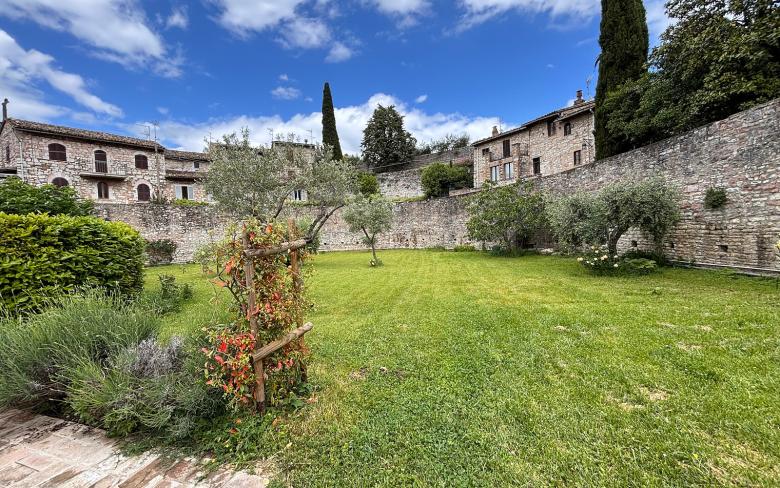The central portal is elaborately carved with floral motifs as well as allegorical figures and animals. In the lunette is a bas-relief of Christ enthroned, the Nursing Madonna and Saint Rufinus, by an unknown artist.
The middle part is decorated with three splendid rose windows; symbols of the four Evangelists surround the central rose window.
The upper part, with a gable roof, was added at the end of the 13th century.
Saint Clare's house was in the vicinity of the bell tower.
The interior which follows the layout of a basilica divided into a central nave and two aisles, was completely modified in 1571 by Galeazzo Alessi (architect of the nearby basilica di Santa Maria degli Angeli). The removal of the side altars in the aisle on the left, revealed part of a Roman wall and the ancient Roman cistern.
At the front of the right aisle is the baptismal font where Saint Francis, Saint Clare and possibly the future Emperor Frederick II were baptised. Nearby is the Chapel of the Blessed Sacrament, decorated in a Baroque style with Eucharist-themed images painted by Giacomo Giorgetti in 1663.
In the apsidal-conch are frescoes by Carlone, Giovanni Antonio Grecolini and Giorgetti. The apse is enhanced by the splendid wooden choir carved by Giovanni di Piergiacomo da San Severino, 1520. To the left of the main altar is a Crucifixion by Dono Doni.
In the central nave, at the sides of the entrance are two sculptures depicting Saint Francis by Giovanni Duprè, 1882, and Saint Clare by Amalia Duprè, 1888.
From the sacristy you reach the oratorio di San Francesco, where Saint Francis retreated before preaching.
The crypt is divided into three naves and contains fragmentary frescoes from the 11th century showing Symbols of the Evangelists.
The Roman sarcophagus from the 3rd century A.D. holds the relics of Saint Rufinus.
Next to the cathedral, you will find the diocesan museum and crypt of San Rufinus.
Adjacent to the museum is the Capitolare Archive, containing many illuminated codes and documents dated as early as 963.
Trivia
According to San Pier Damiani (1052) the remains of Saint Rufinus, Bishop of Assisi and martyr in the 3rd century, were a matter of contention between the Bishop Ugone and the local people. The Bishop wanted to take the saint's body to the then-cathedral of Santa Maria Maggiore. The locals were firmly opposed to the idea and so a "tug of war" contest over the saint's coffin was set up, to decide what to do: seven men from Assisi managed to beat the Bishop's sixty men. After this extraordinary phenomenon, Ugone decided to radically transform the small primitive basilica where the remains of Saint Rufinus were kept from 412.
Opening time
Mon-Tue-Thu-Fri:
(Morning) 10.00-13.00
(Afternoon) 15.00-18.00
Saturday*:
(Continued) 10.00-18.00
Sunday*:
(Continued) 11.00-18.00
Info and booking visits:
www.assisimuseodiocesano.it
































